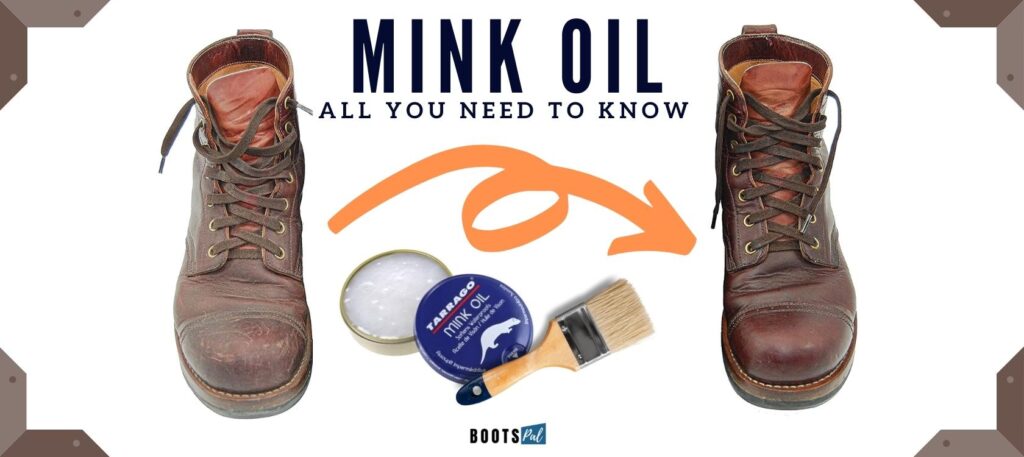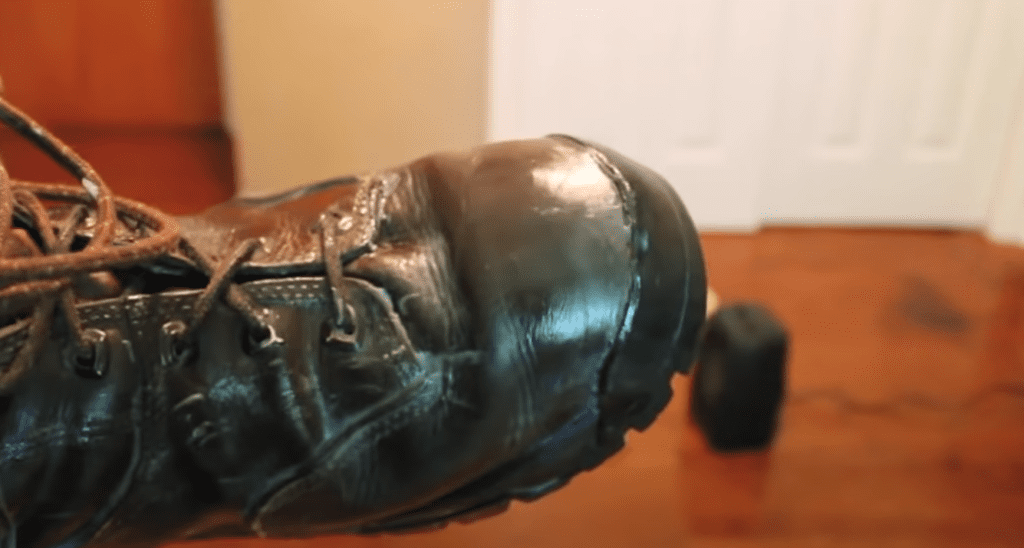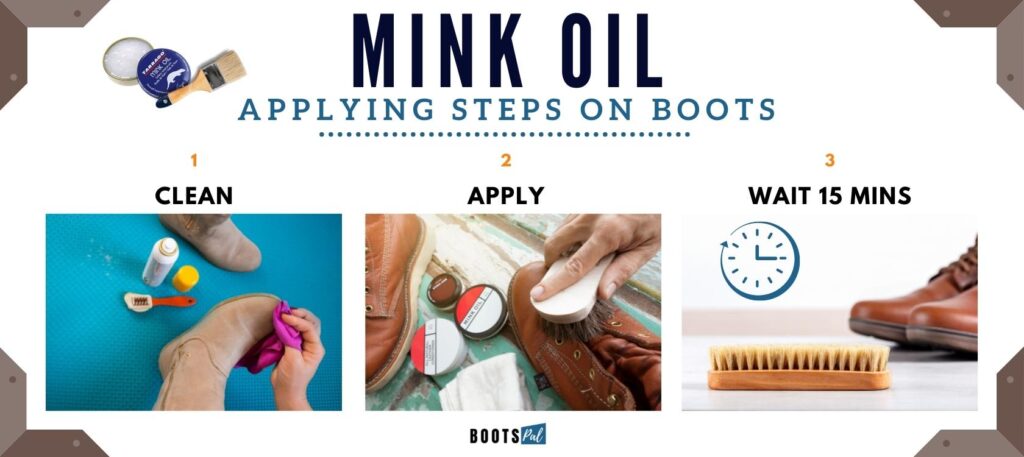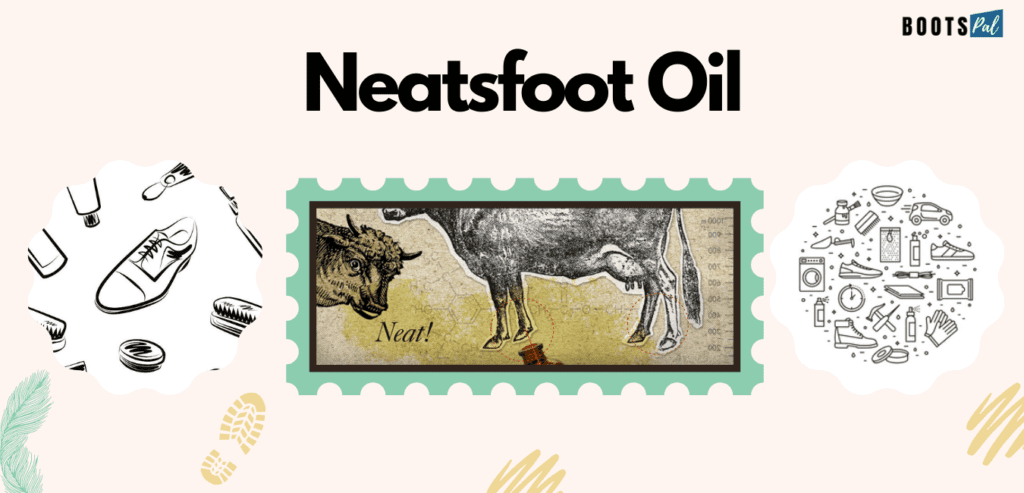Do you have a pair of leather boots and you adore them and don’t want them to become old?
Come on, who doesn’t want that!
Leather is a tough material, but it needs to be taken care of. If you don’t take care of your boots, they can get dry and cracked. Mink oil and neatsfoot oil are two great leather care boot oils that can assist you greatly in preventing leather decay.
But question remains –
Mink oil vs neatsfoot oil – Which one should you use on your loved leather boots or shoes?
Let’s find out!
Neatsfoot oil has been used by bootmakers since 1867 to soften and preserve their products. It contains high levels of fatty acids that nourish leather while protecting it from water damage and other environmental factors like dirt or dust.
On the other hand, mink oil has been used as an all-purpose skin moisturizer since ancient times because its unique composition allows it to penetrate deep into skin cells where it provides long lasting hydration without leaving any greasy residue behind.
So if these are qualities that appeal to you then read on! This article will help you decide which oil is best for your boots so that they stay in great condition. We’ll compare the features, benefits, downsides, suitability and non-suitability about these two market-leading leather boot oils and help you decide which one is the best for your needs.

Mink oil is a very common product used for cleaning and conditioning leather. Mink oil is produced by steam distilling real mink fur. The steam distillation process removes the toxic materials from the mink fur and turns it into a non-toxic product called mink oil.
Mink oil is very effective at cleaning and softening leather. And it does this without leaving any type of residue behind. This makes it a very safe product to use on leather.

How Long Has Mink Oil Been Around For?
Mink oil has been available for commercial sale since the 1940s. It was produced by a group of farmers in Canada who lived in the outskirts of the mink fur industry. However, it wasn’t until 1950 when its primary use was discovered that it became popular among leather workers.
It is still used all around the world today by people who want to take care of their leather boots.
Who Should Use Mink Oil for Boots?
Mink oil is a great option for anyone looking to add some extra protection and nourishment on their boots. Because it has such an effective nourishing ability, this helps restore the look of your leather footwear while providing them with much needed nutrients!
Those who should use mink oil include:
- Anyone with shoes or boots made from all types of finished smooth leather
- People with boots or shoes that have been exposed to water or wet environments
- Those who want to add an extra layer of protection against the elements
- Bikers, hikers, and other outdoor enthusiasts who need waterproofing on their footwear
Who Should not Use Mink Oil for Boots?
Mink oil should not be used by:
- People with shoes or boots made from suede or nubuck leather
- People who have a sensitivity to mink oil or any of its ingredients.
What are the Benefits of Mink Oil?
The benefits of mink oil include:
- It is a non-toxic and safe product to use on leather
- It is very effective at cleaning and softening leather
- Leaves no residue behind
- Is an affordable option compared to some other leather care products
- Easy to find online or in most stores

What are the Downsides of Mink Oil?
The downsides of mink oil include:
- It does not remove tough stains, grease marks, removing dirt and grime from leather like saddle soap can do, especially if they have been exposed to water.
- Does contain animal products (not vegan friendly).
- If overused it may cause damage to the leather.
- Mink oil can be difficult to wash out of your boots if not fully rinsed off-especially the first few times you use it!
How to Use Mink Oil? – A Quick Step-by-Step Guide

The primary task of mink oil is to condition leather boots with light cleaning function. So it is advisable to clean the boots thoroughly before starting applying mink oil. for that, you need to arrange the supplies.
Required Supplies:
- Mink oil
- Water, preferably warm
- Bucket or sink
- Brush(horse hair or regular) or sponge
- Soft microfiber cloth, kitchen tissue or newspaper
- Shoes/boots to be cleaned.
- Dryer
Steps to Follow:
- At first, to remove the loose dirt and grease, use a clean dry lint-free cloth to wipe your boots.
- To clean the leather, moisten a cloth in a bowl of lukewarm soap-water solution and apply on the leather in circular motions.
- For the next few hours, place the leather boots under the sun or near a heater to dry them out completely.
- Apply mink oil to your leather boots, it needed, in multiple layers and keep them away for an hour.
- Remove any excess mink oil using a soft cloth or kitchen tissue.
- Do not forget to use a good leather conditioner to give a fresh, new and shiny look to your boots.
Our Best Suggestion for Mink Oil
Courtesy : lanceoa
What is Neatsfoot Oil?
Neatsfoot oil is an oil that comes from the shin bones and joints of cattle. It has been used for centuries on leather to keep it soft, strong, and waterproofed.
However, as long as neatsfoot oil was harvested from dead animals it could be considered a vegan product. But due to advancements in technology, the production method of neatsfoot oil is a by-product of the leather industry.
It is primarily used to soften and waterproof leather, but it can also be added to polish or dye for extra shine or color protection. Neatsfoot oil is nearly identical to mink oil in composition, especially when coming from the same animal source.

How Long Has Neatsfoot Oil Been Around For?
Neatsfoot oil has been used for centuries and dates back to the 13th century in England. The name comes from “neat,” which is an old-fashioned term for cattle, and “foot,” meaning that it came from the feet or shins of animals.
In 1641, Englishmen were required to pay a tax on leather goods that could only be paid in the form of neatsfoot oil. This shows how popular and essential this product was for the leather industry.
In modern times, neatsfoot oil is still commonly used by leatherworkers because it offers many benefits over other conventional oils such as water resistance and strength against cracking.
Who Should Use Neatsfoot Oil for Boots?
People who should use neatsfoot oil for boots include:
- Anyone with leather boots that need conditioning or waterproofing.
- Anyone interested in restoring old, neglected leather goods.
- Those looking for an affordable option to mink oil for their boots.
Who Should Not Use Neatsfoot Oil?
Those who should not use neatsfoot oil for their boots include:
- Those with allergies to animal products.
- Those who prefer vegan-friendly products.
- Anyone looking for a cleaning oil for their boots.
What are the Benefits of Neatsfoot Oil?
The benefits of neatsfoot oil include:
- It’s affordable, readily available and easy to find in stores.
- Provides treatment to old, neglected leather.
- Does not require extensive preparation and can be easily applied to boots.
- Is Neatsfoot Oil Good for Leather?
What are the Downsides of Neatsfoot Oil?
The main downsides of neatsfoot oil include:
- May not be the best choice for boots that don’t need serious conditioning or waterproofing.
- May require more than one coat and leave a greasy residue if applied too liberally.
How to Use Neatsfoot Oil? – A Quick Step-by-Step Guide

Required Supplies:
- Rubber Gloves
- Toothbrush/horsehair brush
- Neatsfoot Oil (Liquid, Pure, or Neatsfoot Compound)
- Clean Water
- A Clean Sponge or Microfiber Cloth
- Dry cloth/ Newspaper
- Dryer (optional)
Steps to Follow:
- Wash thoroughly your leather boots using a clean, damp cloth. You can use saddle soap to clean your pair with max satisfaction.
- Allow the boots to be dried completely.
- Apply neatsfoot oil to the leather in light, even strokes.
- Apply multiple coats if necessary to restore old or neglected leather goods.
- Allow each coat of oil at least an hour before applying the next one.
- Remove any excess oil with a dry, clean cloth.
- Leave the pair overnight for complete drying.
- Once your boots appear matte and dry, you can buff them with a clean cloth or paper towel for added shine if desired.
Frequency to Apply:
If your boots are just starting to show signs of wear, you can use neatsfoot oil for prevention and conditioning. In that case, apply it once every 1-2 months.
If they’re already showing signs of cracking or wearing down, however, you should use neatsfoot oil more frequently. When using the oil for restoration purposes, apply it once a week until the desired results are achieved.
Pro-tip: neatsfoot oil may not be the best choice for boots that don’t need serious conditioning or waterproofing. It may require more than one coat and leave a greasy residue if applied too liberally.
Our Best Suggestion for Neatsfoot Oil
Differences Between Mink Oil and Neatsfoot Oil
Here is a summarized comparison of the two types of oil to make it easier for you to decide which one might be best based on your requirements.
| Feature | Mink Oil | Neatsfoot Oil |
|---|---|---|
| Ingredients | Obtained by rendering of mink fat which has been removed from pelts | Contains cow bones as its primary ingredient |
| Functions: | ||
| Best suitable for | Softening and waterproofing | Moisturizing |
| Cleaning | Light | No |
| Conditioning | Yes | Yes |
| Waterproofing | Yes | Yes |
| Leather darkening | If used in proper quantity, mink will not darken | There is a high chance of darkening light colored leather |
| Leather Penetration ability | Easily penetrates deeper into the leather as compared to neatsfoot oil | Penetrates, but not as deep as mink oil |
| Consistency | Thick | Lighter |
| Elasticity | Less elastic | More elastic |
| Dry-up time | Dries quickly without leaving any residue behind | Takes more time to dry up |
| Smell | Pleasant smell | Not as pleasant smell as mink oil |
| Suitability | Can be used for all types of leather, even suede | Can be used on finished smooth leather only |
| Versatility | More versatile than neatsfoot oil | A bit less versatile, best for one purpose only |
| Availability | Not easiest, but moderately easy to find in stores | Easier to find in stores |
| Price | Almost the same, but it depends upon the brand and source | – |
| Best Products | Check for details | Check for details |
| More Details | Read our saddle soap article | Read our Neatsfoot Oil article |
9 Points to Consider While Choosing the Better Leather Oil: Mink Oil or Neatsfoot Oil?
Now that we know both the oils, its time for you to decide which one is the better option for your boots.
Luckily enough, we’ve also made up your mind for you by deciding that mink oil is the best choice of oil for your boots. We will now give you why we have made this decision.
While both products are highly beneficial, mink oil has several benefits over neatsfoot oil making it the better choice overall considering the following points:
- Mink oil is 100% vegan friendly.
- Mink oil is more suitable for you if your boots are made of suede or other types of leather which are easily worn off when wet. Mink oil can also be used on any type of leather.
- Mink oil is more versatile as compared to neatsfoot oil.
- Mink oil is not as thick as neatsfoot oil which means that it is easier to rub off onto the boots. This also makes mink oil more suitable for suede type leathers which are hard to penetrate.
- Mink oil penetrates deeper into the leather as compared to neatsfoot oil which makes it more suitable for softer leather types such as suede.
- Neatsfoot oil takes a lot of time to dry up while mink oil dries quickly without leaving any residue behind. This also makes it easier and less messy for you to do the oiling in the house or in your own room.
- Neatsfoot oil most likely darkens the leather while proper amount of mink oil does not.
- Mink oil has a better smell than neatsfoot which is an added advantage for some people.
- Since neatsfoot oil can be used on all types of leather, it is more economical than mink oil.
Frequently Asked Questions
Is mink oil vegan friendly?
Yes, mink oil is a 100% vegan friendly product.
How long can I leave on a layer of mink oil?
You can apply multiple layers of mink oil after each application is completely dry. Be sure not to overdo it, coz it may harm the lather then.
Does mink oil darken leather?
Yes, if you apply mink oil in excess quantities then it may leave a dark finish on light colored leathers.
What types of leather can be treated with mink oil?
Mink oil can be used on any type of leather! – even suede!
Is mink oil bad for leather?
No, mink oil is not bad for your leather boots. It just may darken the color of light colored leathers if you overuse it.
Is neatsfoot oil like mink oil?
No! Neatsfoot oil is for conditioning smooth leather while mink oil can be used on both smooth and suede leathers. It can also be used on gloves and other leather goods as well.
Can neatsfoot oil go rancid?
Yes, neatsfoot oil may even go bad within a year if not used properly or kept in the wrong conditions.
How long does neatsfoot oil take to dry?
Neatsfoot oil takes up to 24 hrs to dry completely! It can be very messy while you do this process at home.
Is neatsfoot oil bad for leather?
No, Neatsfoot oil is not bad for your leather boots. It’s just too thick, messy and takes time to dry!
Can neatsfoot oil darken light colored leathers?
Yes, if you apply neatsfoot oil in excess then it can darken your leather boots. So it is advisable to use neatsfoot oil in small quantities for best results.
Does mink oil seal leather?
No, mink oil doesn’t seal leather. It just waterproofs it to protect the surface from water contact.
How We Carried Out Testing and Research on Mink Oil vs Neatsfoot Oil
We tried to find the answers to the following questions by doing thorough research, asking experts and carrying out testing as well. We have researched hundreds of verified user reviews and selected top 10 products from each category of oil and carried out more in-depth research to find out the desired answer for you. We have looked to find out the answers to the following questions:
- How can you differentiate between mink oil and neatsfoot oil?
- What are the features of mink oil vs neatsfoot oil?
- Which product is more suitable for your leather boots?
- What are the benefits of mink oil vs neatsfoot oil?
- Which one should you choose, mink oil or neatsfoot oil for your leather boots?
We have also purchased two products from both the types of oils for further testing and determined the perfect answer for you.
Final Words
Mink oil and neatsfoot oil are both great options for your leather boots, depending on what you need.
As with most things, there’s no one-size-fits all answer when it comes to taking care of leather boots. It can take some time and trial and error before finding the best product that meets your needs exactly – but we hope this article will help guide you towards an informed decision.
After reading this article, you may have a better idea of which type of oil is the best for your needs. If not, don’t worry! You can always contact us and we’ll help you find out what works best for you.
- Are Steel Toe Boots Safe? Debunking Myths and Unveiling Facts - July 23, 2023
- Ensuring a Firm & Safe Footing: An In-depth Guide to Safety Toes in Work Boots (Types, Features, & More) - July 17, 2023
- Silence the Symphony of Squeaky Steps: How to Stop Leather Boots from Squeaking (And Shoes Too) - July 3, 2023